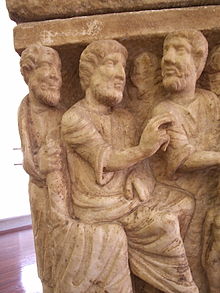
Back Dogmatiese sarkofaag Afrikaans ناووس دوغماتي Arabic Sarcòfag dogmàtic Catalan Sarcófago dogmático Spanish Sarcophage dogmatique French Sarcofago dogmatico Italian Sarkofag dogmatyczny Polish Sarcófago Dogmático Portuguese

The Dogmatic Sarcophagus, also known as the "Trinity Sarcophagus" is an early Christian sarcophagus dating to 320–350,[2] now in the Vatican Museums (Vatican 104).[3] It was discovered in the 19th century during rebuilding works at the basilica di San Paolo fuori le Mura, in Rome, Italy.
Together with the Sarcophagus of Junius Bassus, it one of the most important examples of Christian-Roman sculpture of the Constantinian era. It draws its name from its clear references to the dogmas of the Council of Nicaea (325), in particular to Christ being consubstantial with God the Father, as shown (for example) by the scene of a figure with the appearance of Jesus between Adam and Eve, though whether the figure is to be understood as Christ or God the Father is less clear – the dogmatic point works either way.[1]
- ^ a b Milburn, Robert (1991). Early Christian Art and Architecture. University of California Press. p. 68. ISBN 0-520-07412-2.
- ^ Various scholars give narrower ranges, but the great majority of dates given fall within this range
- ^ There is another "Trinity Sarcophagus" at Arles, alsao with a three-figure Trinity.
© MMXXIII Rich X Search. We shall prevail. All rights reserved. Rich X Search